Castalia’s blog
In the absence of a cure or vaccine for COVID-19, governments and institutions such as the World Health Organization have turned to globally-endorsed COVID-19 prevention guidelines, primarily, regular hand-washing and other hygiene practices, to slow the spread of the virus. Provision of safe and uninterrupted water services, so no one is left behind, is a key objective of governments and utilities at this time.
Many water utilities use ‘disconnection for non-payment’ as a key tool to ensure collections on bill payments. However, collections will be increasingly difficult for many utilities as their customers lose their livelihoods because of the pandemic. Additionally, Governments are issuing freezes and soft payment schedules on utility payments to reduce the financial strain of people affected by the pandemic. Governments and utilities are faced with the crucial task of balancing reliable service provision when it’s getting harder to recover their operating expenses and the return on investments.
Castalia is tracking progress and response to this challenge in some countries/states we work in. The table below summarizes the response in each selected country:
Table 1. Response on Tariffs, Disconnections and Bill Payment
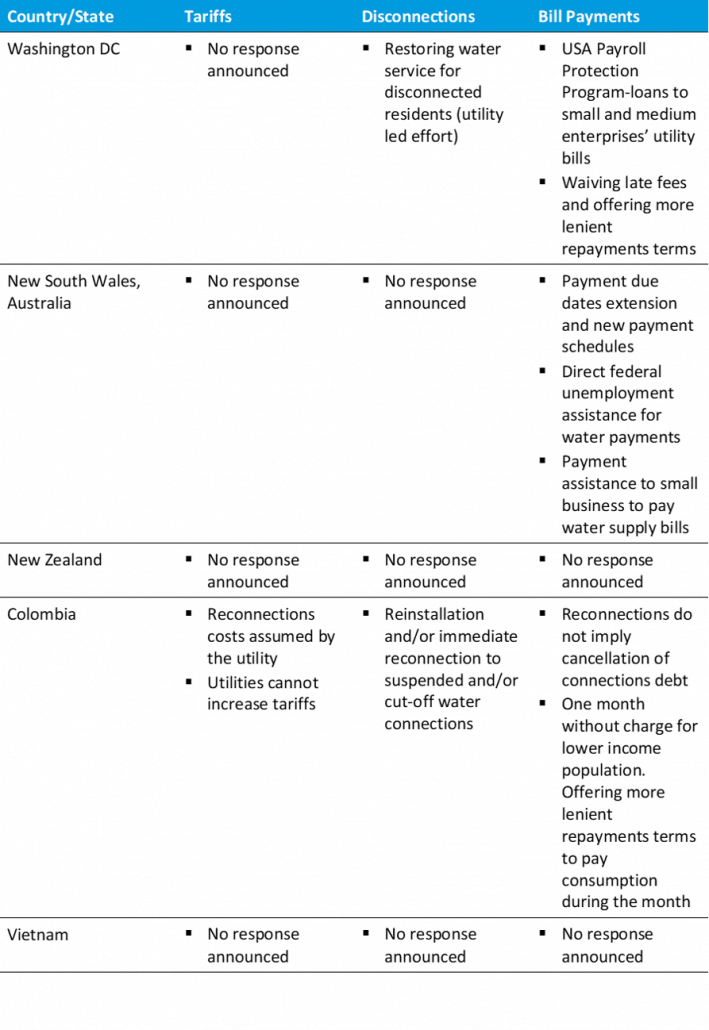
We believe that Governments need to take urgent measures to define financial support mechanisms for water service providers. So far, in the developed countries we have looked into, governments have done little to require forbearance from the utilities, or to support them financially, with a few exceptions. In USA, the Payroll Protection Program loans provide small and medium enterprises with 100% government guaranteed loans to cover not just payroll and rent, but also estimated utility bills. In New South Wales, the Government announced grants up to $10,000 for small businesses struggling to meet utility costs. Both regions, have taken measures to reschedule utilities bills payment for customers. In Washington D.C., the water utility has restored water service for disconnected residents. However, neither New Zealand nor Australia has taken measures for reconnections.
Colombia was quick in its response to protect consumers with a rational and comprehensive plan. However, the Government has not provided a complementary mechanism to support utilities financially. The Government’s National Decree allows for reconnections (more than 200,000 households have been reconnected), stops tariff increases during the State of Emergency, and allows local governments to use alternate means of supply to provide water services when necessary. The National Decree did not specify any mechanisms to support utilities. In the past few days, the National Regulator clarified that water services cannot be free of charge. The regulator insisted that cost recovery and tariff payments should be guaranteed to utilities, and suggested mayors to subsidize water services to relieve low-income households from water costs, as defined in the current laws.
Other developing countries have not yet enacted measures on tariffs, disconnections and bill payments. In Vietnam, the Government has not announced any measures to support utilities or customers in this pandemic. Utilities are running business as usual and customers are expected to pay the bills on time, despite the financial strain of the pandemic. The South African Government has taken some measures to ensure water supply to communities through communal water storage with water collection points and interim containerized sanitation systems. However, the Government hasn’t made public announcements about supporting utilities during these times. In Mozambique, the agency in charge of small-town water supply just asked for an emergency fund for small private operators in some towns, worried that the operators are likely run out of money and stop providing water services.
While it remains important to specify the legal accommodations utilities must offer their customers during this period, we believe that governments will benefit from providing mechanisms to ensure that utilities remain financially viable during a period of low cash receipts due to the pandemic.
As the pandemic extends and continues affecting the global economy, we foresee governments taking measures to finance cashflow shortages of utilities. Access to international funds could be a viable option to finance water utilities. Although these can be considered risky loans, they can be secured against revenue escrows and government guarantees.
We are keen to track updates and changes in policies in countries we work in and hope to share new developments on this blog.
Author: David Hernandez
Share this entry
Both Australia and New Zealand have initiated unprecedented social and economic restrictions in response to COVID-19, and both appear to be about equally successful at bringing the epidemic under control. However, while the lockdowns in the two countries may look similar, they are in reality quite distinct in terms of their restrictions on economic activity and lifestyles. What can both countries learn from the differences in their approaches and what does it mean for a possible gradual removal of restrictions?
The New Zealand Government commenced self-isolation policies on 25 March 2020 with restrictions that focussed on confining people to the household unit (or “bubble”). Australia progressively escalated its restrictions, with a key lockdown announcement on 29 March 2020 directed at limiting activities where congregation of people occurs.
The Australian State and Federal governments, as well as New Zealand’s government will face choices about whether, for how long and to what extent to continue with lockdown policies. The wellbeing impacts of the lockdown are large, even if difficult to measure right now. On one hand the policies appear to be limiting the spread of the disease. On the other hand, there are a range of other impacts on welfare.
From this comparative analysis, Australian policies appear, on the limited evidence, to be effective with fewer negative impacts on wider wellbeing. Australia also appears better placed to rebound when restrictions are lifted. New Zealand’s policies have contained people to household “bubbles” with consequential impacts on activity such as work and education. New Zealand may have more difficulty rebounding.
The States and New Zealand are good comparators because all have similar urbanisation rates (between 86 and 90 percent), demographic profiles, cultures and legal systems.
Different Approaches to Lockdown in Australian States and New Zealand
New Zealand has a unitary government. Each Australian State is responsible for implementing its own set of rules. However, the public health directives implementing the restrictions are all very similar. There are differences between the States’ policies (for example, golf is permitted in New South Wales, but not Victoria), however, the general approach to workplaces and activities is the same.
With this in mind, while the headlines sound the same—Australia and New Zealand in lockdown—there are important differences between the two countries.
In summary, while borders are generally closed:
- Australia’s restrictions are activity based. Activities are limited where people can randomly encounter one another, but most workplaces are able to continue operating subject to compliance with social distancing rules
- New Zealand’s restrictions confine each household to their own “bubble”. Leaving home is only permitted for acquiring essential items and for exercise. A limited set of essential services and businesses may continue.
The table below draws out the differences in more detail.
Table 1: Lock-down Policies in New Zealand and Australian States
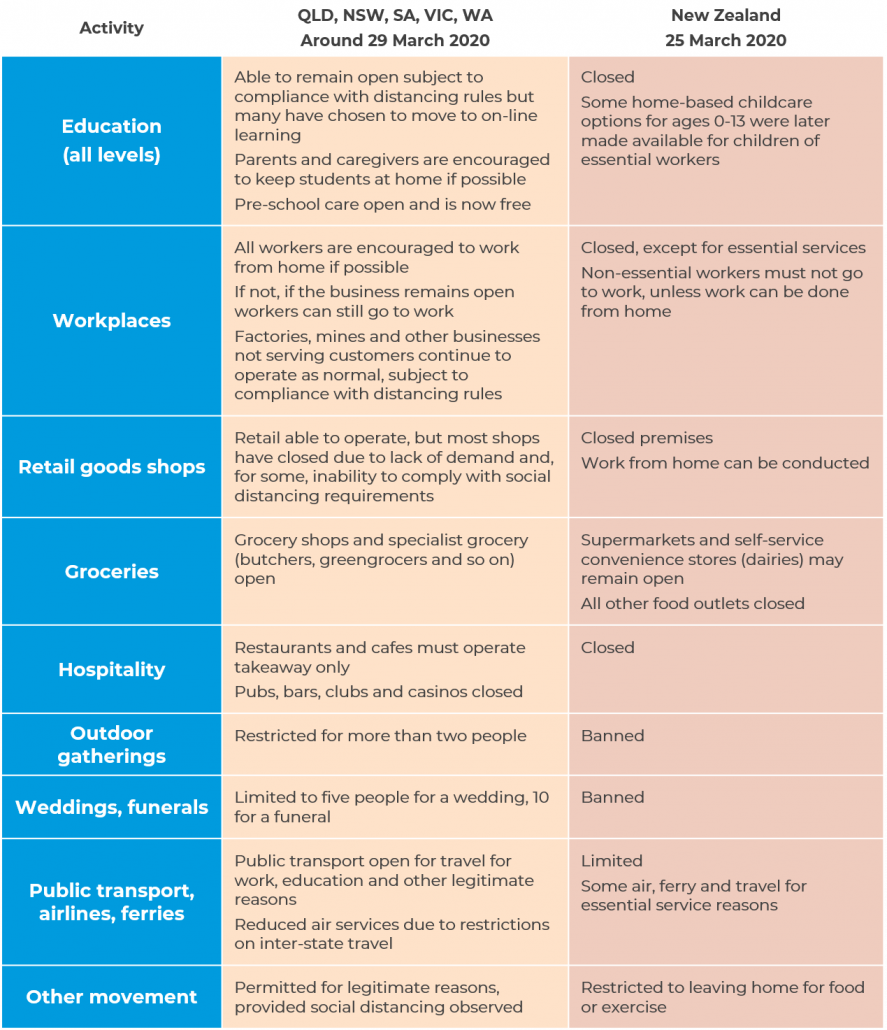
Source: Castalia
Australian “activity-based” approach allows a wider range of activity to continue
Australia’s lockdown approach substantially reduced activities which involve large number of random interactions between individuals (in bars, restaurants, entertainment and sports venues) but largely left the economy free to operate subject to compliance with guidance about workers keeping social distance.
This means businesses can still function, even if in a low-level holding pattern. For example, even if a business is closed (for example, a pub) business owners can visit the premises to maintain equipment or catch up on paperwork. Employees can go to work, unless they are able to work from home.
Australia has allowed continued interactions between people in workplaces and education facilities. However, these are largely controlled settings: factories, construction sites, schools, tertiary education institutions. This means that employers (and if need be public health officials in case of an outbreak) know who is interacting with whom. Workers sign in and attendance rolls are usually kept. Interactions between people can be structured and rule bound.
New Zealand’s “bubble” approach constrains more activity
New Zealand’s household “bubble” approach limits all economic activity to essential services and work that could be done from home. All non-essential business that cannot be carried out from home has stopped. Essential businesses are those essential to the provision of life and the businesses that support them. For non-essential workers, this means that leaving the home is forbidden except for attending to essential business (buying food, seeking medical help or supplies, outdoor exercise near the home).
The effect has been to shut most customer facing SMEs. All retail except supermarkets and convenience stores are closed. Limited exceptions have been progressively made as the lockdown goes on (for example, modestly expanding the definition of essential goods, permitting groundskeepers to maintain turf).
The policies have had major implications for supply chains. Since essential items may only be sold, logistics has become more complicated. The food supply chain had to rapidly change since now almost all food is distributed through two supermarket chains, rather than wholesalers, specialist shops and cafes or restaurants.
2 Similar Epidemiological Results
On raw data, most Australian States have had a lower rate of COVID-19 spread than New Zealand. New South Wales has had the highest rate of COVID-19 spread of the six jurisdictions, followed by New Zealand and South Australia. Queensland, Victoria and Western Australia have had a similar rate of disease spread. Policymakers should be pleased that the spread of the virus is being contained, as the number of new cases decreases. Allowing for uncertainties around testing and the small numbers involved, we could generally conclude that all Australian States and New Zealand have achieved broadly similar COVID-19 outcomes.
In Figure 1 below shows the rate of infections from the point in time that 5 cases per 1 million population were recorded in each jurisdiction. The disease appears to have arrived around two weeks later in New Zealand, so starting all jurisdictions from the same point is useful for comparison purposes. The chart shows a more rapid increase in cases in New Zealand, despite the earlier and more restrictive rules.
Figure 1: COVID-19 Cases per 1 Million Population Since 5 Cases per 1 Million
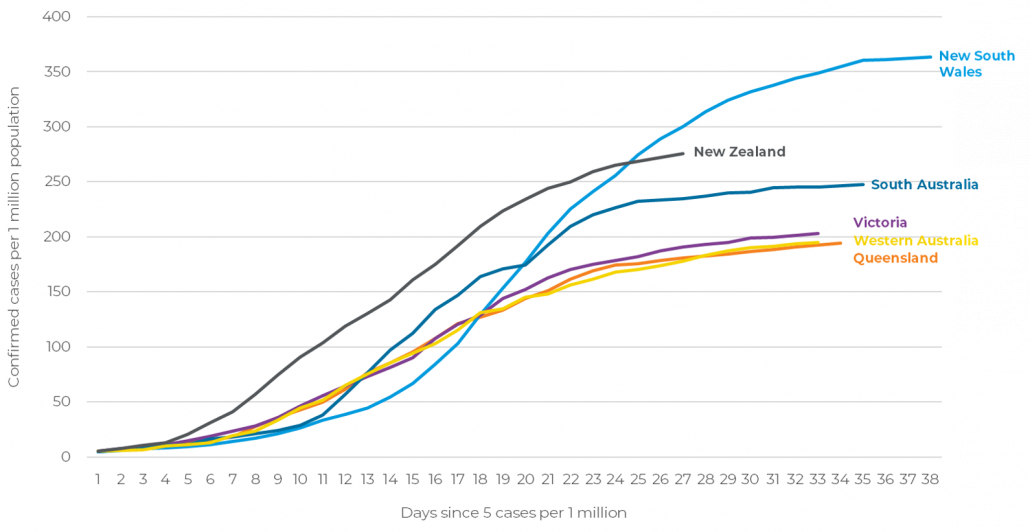
Source: New Zealand and State government announcements
Note: Current to 14 April 2020
All the States and New Zealand have seen a flattening of the epidemiological curve. Figure 2 shows the rate of increase of confirmed cases since lockdown policies were implemented. It is likely that lockdown policies have played an important role, in addition to other factors (for example demographics, climate, other behavioural responses).
Figure 2: COVID-19 Cases per 1 Million Population Since Lockdown Policies Implemented
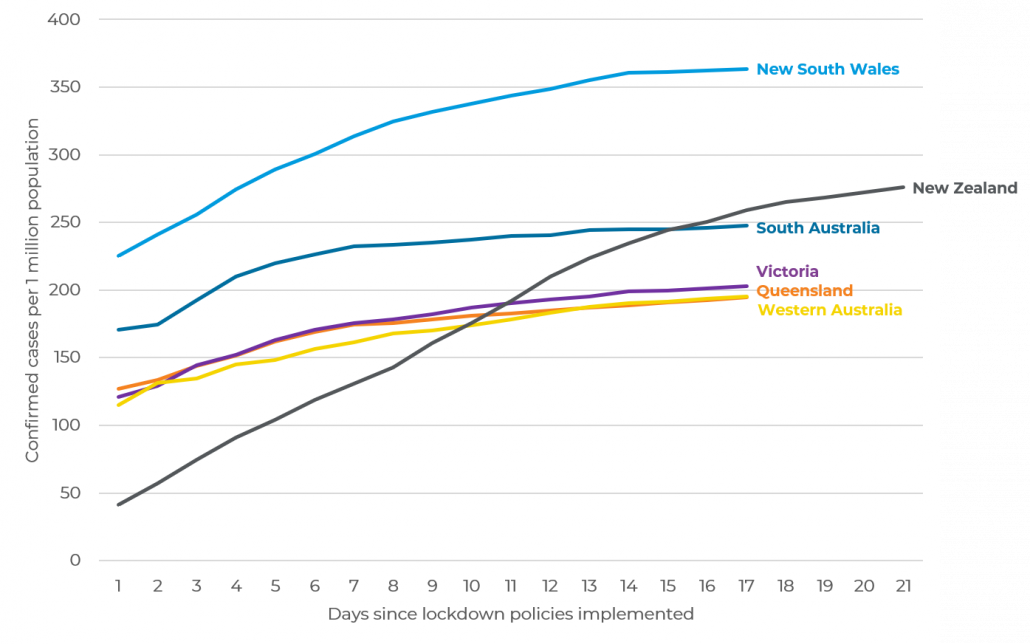
Source: New Zealand and State government announcements
Note: Current to 14 April 2020
Australia has high rates of COVID-19 testing but New Zealand is catching up
The rate of tests for COVID-19 has been high in Australia compared to other countries (for example, higher than South Korea, United Kingdom and United States). New Zealand has now increased its testing rate, but lags behind South Australia and New South Wales. New Zealand had conducted fewer tests per 1,000 population than all of the States until early April (when it matched Western Australia and then Victoria). Figure 3 illustrates this.
Figure 3: Testing Rates for COVID-19 per 1,000 Population
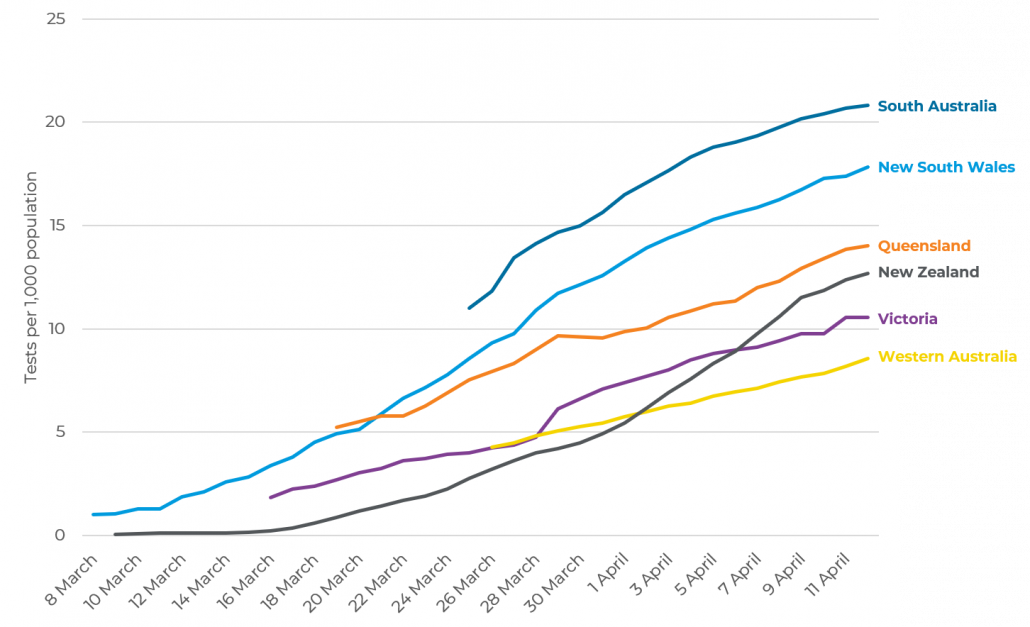
Source: Our World in Data 2020, www.covid19data.com.au
3 Policy Implications from Australia/New Zealand Comparison
Governments on both sides of the Tasman will face choices about the next steps to manage COVID-19. The choices are about whether, for how long and to what extent to continue with lockdown policies. There are trade-offs to make between the epidemiological and health outcomes and impacts on other aspects of wellbeing.
The impacts of the lockdown on wellbeing are intuitively obvious, even if it is difficult to measure some impacts right now. There are the positive impacts of containing the virus (reductions in spread, preventing serious illness and deaths). However, there are also serious negative impacts on other aspects of wellbeing. Shutting down large parts of the economy completely will also make the recovery more difficult.
Australian approach leaves the economy better placed to rebound when restrictions are relaxed
Most Australian States are managing to contain the spread of the disease even with continued controlled operation of businesses and other institutions. It appears from the data in Figure 1, above, that transmission has been slowed. If outbreaks do occur, public health officials can probably more easily track the spread (so-called contact tracing). Workplaces and educational institutions are controlled and structured places, where entry and attendance can be recorded.
Australia seems better placed to recover from the lockdown period. While many businesses have been closed to the public, some ongoing ‘holding pattern’ activity continued. Many other businesses, including SMEs, have remained operational.
This means that when lockdown restrictions can be lifted, Australian businesses will be better placed to rapidly respond to consumer demand. Employees are more likely to have been retained. Trade will have continued for some businesses.
New Zealand will have more challenges in the post-lockdown phase
Most businesses in New Zealand will currently have no or very limited revenues, but will have continuing costs such as rents, wages and other bills. This will have consequences for ongoing viability and employees’ prospects. New Zealand’s firms are mostly small or medium sized enterprises (SMEs) without large balance sheets to absorb major shocks. Young people are not in education or are being supervised by parents at home, which creates its own pressures. There will be mental illness ramifications because of continued confinement, job losses and uncertainty about the future. Police are reporting higher instances of domestic violence due to people being at home with each other more than usual.[1]
When the lockdown policies are lifted, the businesses that are still in operation will face a double challenge. Consumer demand be suppressed, and many New Zealand businesses will have the additional challenge of restarting from zero activity.
EDIT: An earlier version of this blog did not make clear that some public transport in New Zealand continues to operate.
Update: On April 21, this blog post was referenced by The New York Times in their article about New Zealand’s economic recovery post COVID-19.
[1] https://www.nzherald.co.nz/nz/news/article.cfm?c_id=1&objectid=12324065
Image by Fernando Zhiminaicela
About the Authors: Andreas Heuser is a Manager in Castalia’s New Zealand office and Alex Sundakov is Castalia’s Executive Director in Australia.
Disclaimer: The views expressed are those of the authors alone. This work has not received funding from any other organisation or interest.
Many governments are concerned about how to stimulate economic activity once the COVID-19 health crisis is in a manageable state.
This blog examines New Zealand’s unique stimulus approach, which focuses on “shovel-ready” infrastructure. This approach promises to stimulate economic activity while minimizing risks of wasteful spending. The New Zealand approach could inform how governments and multilateral development banks (MDB) approach financial stimulus support in developing countries.
Infrastructure spending is a safe stimulus option to overcome the unprecedented demand shock.
The world will be able to get back to
work once the pandemic spread slows, probably later this year. It will be
essential to get people back to work quickly and stimulate economic activity. Furthermore,
the infrastructure spending could make the post-crisis world more resilient.
Sound infrastructure underpins all
economic activity and, in most countries, infrastructure constraints are
usually well-understood by both the government and the private sector. Therefore,
with appropriate controls in place, the chances that a government-supported
infrastructure project will fail to stimulate economic activity, or be wasteful
in the long term, are lower than for a non-infrastructure project.
New Zealand’s “shovel-ready” approach is interesting.
New Zealand has an interesting and
potentially replicable idea for fiscal stimulus. The government has announced a
plan to increase infrastructure spending quickly once the pandemic restrictions
end. What is special about the New Zealand approach is that the government has
announced the plan now, even though it may be months before it can be
implemented.
The government has called for information about “shovel-ready” projects. These are infrastructure projects that can commence in the next six to 12 months. The deadline for submitting information is 14 April 2020.
By announcing and kicking off this plan
now, in the midst of the pandemic restrictions, the government is providing a
clear signal of its intentions, and some certainty to the infrastructure sector
about which projects might be under consideration for fiscal support.
The New Zealand plan rapidly identifies
potential infrastructure projects that can be commenced soon. This increases
the likelihood that the positive economic impact of infrastructure project
development occurs during the period that demand is suppressed and people are
out of work. The plan also provides government support at a time when economic
activity in the private sector is likely to be low, thus reducing potential
“crowding out” of private spending.
New Zealand’s criteria and process for “shovel-ready” infrastructure projects.
New Zealand has appointed a reference
group of infrastructure experts and senior officials to receive information
about potential projects. The group will further develop criteria to evaluate
projects for the Government to consider.
At this initial stage, in addition to the
time-driven “shovel-ready” requirement, the following high-level criteria will
apply:
- Demonstrated positive direct and indirect employment effects
- Demonstrated social, environmental and economic benefits, with
emphasis on the New Zealand Treasury’s Living Standards Framework and the UN’s
Sustainable Development Goals.
Project developers must also outline how
COVID-19 has affected the project and how COVID-19 presents risks to on-time
construction and completion to specifications. Project developers are also
asked to outline specifically how Government could support their project. This
can include:
- Financial support
- Expedited regulatory approvals (for example, environmental permits
or planning permissions) - Regulatory or law changes to enable infrastructure (for example, fast-tracking
foreign investor rules) - Other government support (for example, commitments by government to
use the infrastructure or purchase services).
The full criteria and process for
evaluating projects will be developed in the coming weeks. New Zealand has
well-developed infrastructure evaluation frameworks for public capital
investment (Better Business Case framework, overseen by the Treasury). We
expect further information on a robust evaluation process to emerge soon.
Developing countries can develop a “stimulus tool kit” borrowing from New Zealand’s “shovel-ready” approach.
There are some lessons from the New
Zealand approach that developing countries and MDBs could apply. Developing
countries are likely to be fiscally stretched, and therefore infrastructure
stimulus might be financed by MDBs and other donors.
Many countries will want MDB support.
MDBs should consider developing a “post-COVID infrastructure stimulus toolkit”,
which any interested country could adopt.
The toolkits should be rolled out as soon as possible. This will allow countries to identify projects and get them shovel ready now. An information-gathering exercise, such as the New Zealand “shovel-ready” approach, can be done quickly. The sooner MDBs begin to think about criteria for infrastructure finance, the faster infrastructure developers and investors can respond with projects that can deliver immediate economic and longer-term resilience benefits.
Key features, which can be rapidly
developed, include:
- Ensuring a project evaluation body is appropriately qualified and suitably independent
- Identification of the key results sought from projects, such as jobs, environmental sustainability, social inclusiveness, and resilient infrastructure
- Mechanisms to determine project timeframes and risks to meeting timeframes.
Some precedents already exist for rapid disbursement methodologies. These could be applied for post-COVID infrastructure. P4R (Pay for Results) could be incorporated. A P4R loan, for example, could disburse X amount per km of road built to the required standard, which would be much quicker than normal MDB processes.
Even so, provisions to ensure that the projects funded are ones that are needed, would be important—here the New Zealand “shovel-ready” criteria could be considered as a base. Proper construction supervision would need to be ensured also.
Author: Andreas Heuser, Andreas.Heuser@castalia-advisors.com
Disclaimer: The views expressed are those of the author’s alone. This work has not received funding from any other organisation or interest.
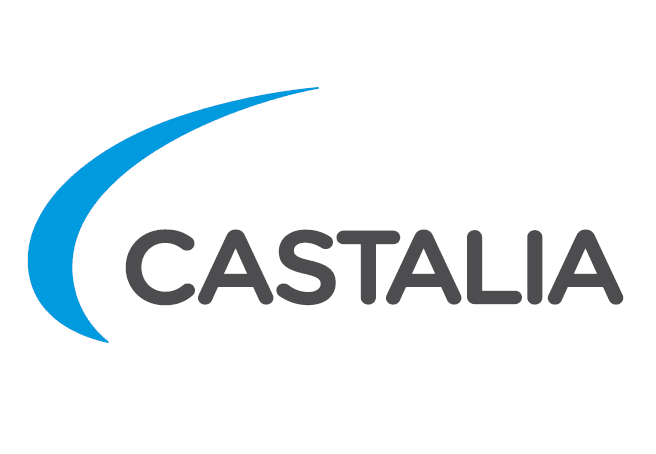
 Image by
Image by 














